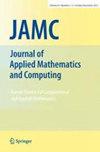Fractional-order rat bite fever model: a mathematical investigation into the transmission dynamics
IF 2.7
3区 数学
Q1 MATHEMATICS
引用次数: 0
Abstract
The fractional ordered mathematical model offers more insights compared to integer order models. In this work, we analyzed fractional order rat bite fever model. We employ the Adams–Bashforth–Moulton method in conjunction with fractional-order derivatives in the Caputo sense to study the model. The work demonstrates how fractional derivative models offer an increased degree of flexibility to investigate memory effects and illness dynamics for a particular data set. Further, an analysis of the aforementioned model including its existence, uniqueness, and stability is considered. The distinct parameter estimation for every value of the fractional order highlights the importance of this work.

分数阶大鼠咬伤热模型:传播动力学数学研究
与整数阶模型相比,分数阶数学模型提供了更多的启示。在这项工作中,我们分析了分数阶鼠咬热模型。我们采用 Adams-Bashforth-Moulton 方法结合 Caputo 意义上的分数阶导数来研究该模型。这项工作展示了分数导数模型如何为研究特定数据集的记忆效应和疾病动力学提供了更大程度的灵活性。此外,还考虑了对上述模型的分析,包括其存在性、唯一性和稳定性。对每一个分数阶值进行不同的参数估计凸显了这项工作的重要性。
本文章由计算机程序翻译,如有差异,请以英文原文为准。
求助全文
约1分钟内获得全文
求助全文
来源期刊

Journal of Applied Mathematics and Computing
Mathematics-Computational Mathematics
CiteScore
4.20
自引率
4.50%
发文量
131
期刊介绍:
JAMC is a broad based journal covering all branches of computational or applied mathematics with special encouragement to researchers in theoretical computer science and mathematical computing. Major areas, such as numerical analysis, discrete optimization, linear and nonlinear programming, theory of computation, control theory, theory of algorithms, computational logic, applied combinatorics, coding theory, cryptograhics, fuzzy theory with applications, differential equations with applications are all included. A large variety of scientific problems also necessarily involve Algebra, Analysis, Geometry, Probability and Statistics and so on. The journal welcomes research papers in all branches of mathematics which have some bearing on the application to scientific problems, including papers in the areas of Actuarial Science, Mathematical Biology, Mathematical Economics and Finance.
 求助内容:
求助内容: 应助结果提醒方式:
应助结果提醒方式:


